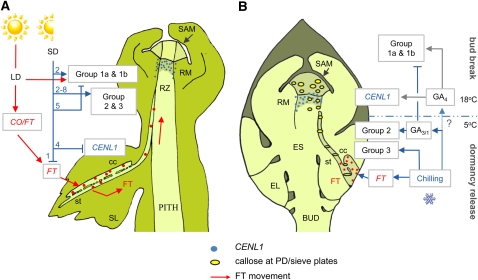Figure 10.
Heuristic Model of Signal Production and Conduit Regulation during the Dormancy Cycle in Populus.
(A) Dormancy induction trajectory. In LDs (red arrows) the clock-regulated module CO/FT produces FT in the companion cells (cc) of source leaves (SL). FT is loaded into the sieve tubes and transported to the shoot apex, unloaded into the rib zone (RZ), and transported to the RM. Sieve plate pores and plasmodesmata are maintained in a conductive state mainly by group 1a and 1b GH17 proteins (see below). Under SDs (blue arrows), FT is completely downregulated within a single week (1), which eventually results in the establishment of dormancy. At about the second week of SDs (2), members of groups 1 and 2 GH17s are transiently upregulated to maintain symplasmic paths to facilitate bud formation, but downregulated before week 5. Some other GH17 members of groups 2 and 3 become upregulated at this point. CENL1 is downregulated from week 4 onwards, and dormancy is established at week 6.
(B) Dormant bud and the enclosed embryonic shoot (ES). Chilling (blue arrows and bar) upregulates FT in the companion cells of embryonic leaves (EL) and group 3 GH17s. Meanwhile, chilling-enhanced production of GA increases GA3-inducible group 2 GH17s, which remove dormancy callose from sieve plate pores and PD in the RM and SAM, thereby providing functional conduits for FT transport to the RM. After sufficient chilling, elevated temperatures (18°C), mediated by GA4 (gray arrows), upregulate growth-related groups 1a and 1b GH17s. Arrows indicate upregulation, and T-bars indicate downregulation of genes.

